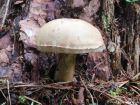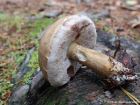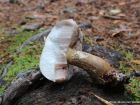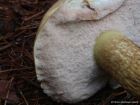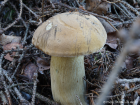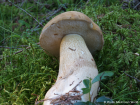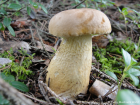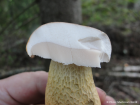Cap colour ranges from grey-yellow to pale or walnut-brown, starting slightly downy and later developing a smooth, matte lustre. It begins as convex and flattens with maturity. The flesh is whitish with a pinkish tinge beneath the cap cuticle, remaining unchanged; it is thick and firm. Pores initially pale cream but later turning pinkish, the tubes are round, densely packed and fairly small, terminating in palid pores spaced between 1 and 2 per mm that turn coral pink as the fruitbody matures. Stem club-shaped, ranging from whitish to pale brown above, and paler brown to tan below. It features a pronounced network pattern in brown, forming wide meshes, particularly on the upper third. The base has a white basal mycelium. It has no ring. Spore print brownish pink.
Microscopic Features: Spores are subfusiform, measuring 11-15 x 4-5μm.
Tylopilus felleus on the www.first-nature.com web site.
Tylopilus felleus on the MushroomExpert.Com Web site.
Many mushrooms are poisonous, and some can be lethally toxic. Distinguishing between edible and poisonous mushrooms can be very challenging. Therefore, we strongly advise against consuming wild mushrooms. This website does not contain any information about the edibility or toxicity of mushrooms.
Although efforts have been made to ensure accuracy on this website, the information may contain errors and omissions. Therefore, all content provided is for educational and informational purposes only and should not be relied upon or used as a basis for consuming any plants or mushrooms.
External links are provided for reference only. We do not endorse or take responsibility for the content, advice, or products found on these sites or in any advertisements shown on this website.
